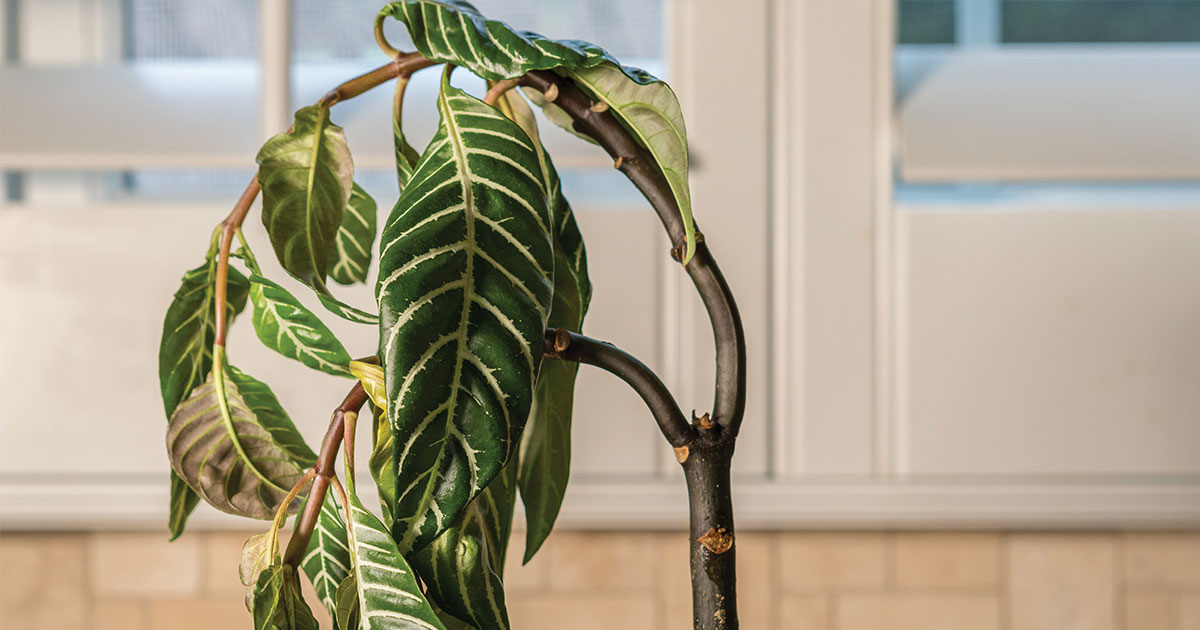Not all plants are transparent with their needs. Take the beautiful peace lily, for instance. The emerald leaves will begin to wilt as an indication the soil lacks moisture. By pushing one finger six inches through the surface, you will be able to determine the condition of the soil. For a quick pep-me-up solution for dry soil, all it requires is a drink of water; however, a larger problem may arise when a plant receives too much water. Air will be pushed out of the soil and suffocate the roots. Stress will be noticed through the color of the leaves; perhaps changing from a rich green to a sickly lighter coloring, and before long, spot before turning brown. A quick relocation to a new pot may be the solution. Not all plants survive stress and sickness. The best news of all is that if plants are healthy, they can rebound from unexpected problems! Identifying the signs, acting immediately, and implementing a remedy can improve the results.
Plant Shock
A second reaction to wilting relates is to provide too much sunlight. Plant shock will be noticeable by a change of color in the leaves termed bleaching. The discoloration could be a result of sunburn, or a response when plants have not had the time to adapt to a new location, such as a placement in direct sunlight and heat. The solution is to move the houseplant into a location with the greatest amount of shade, and to expose tender plants to sunlight gradually over a few days. Do not worry about sunburn; removing the deadened leaves will foster new healthy shoots. After a few weeks, houseplants should be well adapted to thrive outdoors.
If planting in a garden, pair up with flowers that would be considered heat-loving perennials such as black-eyed Susans, coneflowers, coreopsis, daylilies, lantana, Russian sage, and verbena, and incorporate herbs such as thyme and rosemary. Many herbs will attract the good insects to devour the ones which cause havoc. Tall flowers can easily shield less heat resistant plants. (Take notice of the sun’s movements and plan well before planting!)
Soil Deficiencies
Blue, red, yellow, and purple are not colors one would naturally expect from green leaved plants. Blueberry plants, for instance, will turn bright red due to poorly drained soil when low levels of nitrogen or phosphorous are present. (If you are seeing a lack of growth, relocate and amend the soil with pine bark, compost, and sand to improve drainage.) Tomato plants, corn stalks, and marigolds will often have a phosphorous deficiency by displaying reddish-purple leaves. A liquid fertilizer will help balance the problem, which may be due to poor soil or drainage issues. Supplementing the soil with compost (such as banana peels, crushed egg shells, and coffee grounds, added directly around your plants will help boost the minerals in the soil.
Banishing Insects
Amidst the gardening season, gardeners may be unaware of the insects that either gravitate toward leaves or are found within the soil.There are steps you can take to make your garden less inviting to those pests. A squash plant, for instance, will thrive one day, and be weak and defenseless the next. Aphids, a small insect, will consume the underside of leaves and the trunk. Spray immediately with a strong blast of water, or use insecticidal soap. (Aphids can also destroy your house plants, too!)
Click beetles, found in the soil, feed on the root of the plant. You will notice the plant becoming weaker, and unable to grow. While they thrive in poor soil, it is important to prepare the soil by tilling and adding healthy compost or a soil conditioner prior to planting.
Beyond a drink of water, our plants show us their state of health, and often it is seen in the leaves. Take a long purposeful stroll through your garden to be watchful for signs. Lift leaves and inspect for insects, spots, or discoloration. You may be the one who can act fast, provide a remedy, and revive a plant in a state of stress!






















